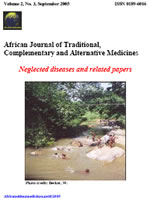
|
African Journal of Traditional, Complementary and Alternative Medicines
African Ethnomedicines Network
ISSN: 0189-6016
Vol. 14, No. 6, 2017, pp. 10-19
|
 Bioline Code: tc17152
Bioline Code: tc17152
Full paper language: English
Document type: Research Article
Document available free of charge
|
|
|
African Journal of Traditional, Complementary and Alternative Medicines, Vol. 14, No. 6, 2017, pp. 10-19
| en |
AN INSIGHT INTO THE USE OF COMPLEMENTARY AND ALTERNATIVE MEDICINES AMONG PATIENTS WITH ATOPIC ECZEMA IN CENTRAL DURBAN, SOUTH AFRICA
Thandar, Yasmeen; Botha, Julia; Sartorius, Benn & Mosam, Anisa
Abstract
Background: Complementary and alternative medicines (CAM) are increasingly popular globally with frequent use
amongst patients with atopic eczema (AE). Despite increased AE prevalence in South Africa (SA), no local data on
CAM-use for this disease exists.
Methods: A cross-sectional study utilizing a comprehensive questionnaire qualifying and quantifying CAM use in
patients with AE. We interviewed 206 AE patients; 106 from a public hospital dermatology clinic and 100 from private
dermatology practices in central Durban. One-way analysis of variance (ANOVA) compared means of continuous
predictors across 3 or more groups. Differences in frequencies of categorical explanatory variables by CAM and AE
were assessed using Pearson chi-square (χ2) test or Fishers exact test.
Results: There were 143 children, 63 adults; 163 females and 43 males. Races represented were Black (56%), Indian
(33%), Coloured (6%) and White (4%). 135(66%) reported current or previous CAM use. Common reasons were
family/friends’ recommendations (42%) and media-influence (23%). Frequently used CAMs were vitamins (35%),
aromatherapy oils (27%), herbal creams (26%), traditional African medicines (23%) and homeopathy (19%). Nondisclosure
to the dermatologist was high (59%). Almost half (48%) said they were not questioned about CAM use.
More Indian patients used CAM (p=0.001) and Muslims were most frequent CAM users (p=0.044). Although not
statistically significant, the more educated and higher income bracket used CAM more. 28% felt CAM had fewer side-effects,
28% felt it was safer than conventional medicine and 35% felt CAM was more natural.
Conclusion: The detailed trends of CAM use by South Africans for AE is an important addition to the current
literature. Dermatologists and healthcare professionals addressing patients with AE need to be more familiar with CAM
types that patients may explore as this could impact on the overall clinical outcome.
Keywords
Dermatology; complementary medicines; alternative medicines; atopic eczema
|
| |
© Copyright [2017] - African Journal of Traditional, Complementary and Alternative Medicines
Alternative site location: http://journals.sfu.ca/africanem/index.php/ajtcam
|
|
